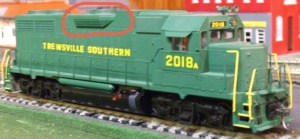Dynamic brake
Dynamic braking is the use of the electric traction motors of a railroad vehicle as generators to slow the vehicle. It is termed Rheostatic if the generated electrical power is dissipated as heat in brake grid resistors and Regenerative if the power is returned to the supply line.
Dynamic braking lowers the wear of friction braking components and additionally Regeneration can also lower energy consumption.
Principle of operation
During braking the motor fields are connected across either the main traction generator (Diesel-electric loco) or the supply (Electric locomotive) and the motor armatures are connected across either the brake grids or supply line. The rolling locomotive wheels turn the motor armatures, and if the motor fields are now excited, the motors will act as generators. For a given direction of travel, current flow through the motor armatures during braking will be opposite to that during motoring. Therefore, the motor exerts torque in a direction that is opposite from the rolling direction. Braking effort is proportional to the product of the magnetic strength of the field windings, times that of the armature windings. For permanent magnet motors, dynamic braking is easily achieved by shorting the motor terminals, thus bringing motor to a fast abrupt stop.
Regenerative braking
Template:Main In electrified systems the similar process of regenerative braking is employed whereby the current produced during braking is fed back into the power supply system for use by other traction units, instead of being wasted as heat. It is normal practice to incorporate both regenerative and rheostatic braking in electrified systems. If the power supply system is not "receptive", i.e. incapable of absorbing the current, the system will default to rheostatic mode in order to provide the braking effect. Research is ongoing into the use of onboard energy storage systems which may in the future allow the recovery of this energy which would otherwise be wasted as heat.
Blended braking
Dynamic braking alone is insufficient to stop a locomotive, as its braking effect rapidly diminishes below about 10 - 12 mph (16 - 19 km/h) Therefore it is always used in conjunction with the regular Air Brake. This combined system is called blended braking. Li-ion batteries have also been used to store energy for use in bringing trains to a complete halt.[1]
Although blended braking combines both dynamic and air braking, the resulting braking force is designed to be the same as what the air brakes on their own provide. This is achieved by maximizing the dynamic brake portion and automatically regulating the air brake portion as the main purpose of dynamic braking is to reduce the amount of air braking required. This conserves air and minimizes the risks of over-heated wheels. One locomotive manufacturer, EMD, estimates that dynamic braking provides between 50% to 70% of the braking force during blended braking.
Self-load test
It is possible to use the brake grids as a form of dynamometer or load bank to perform a "self load" test of locomotive engine HP. With the locomotive stationary, the MG output is connected to the grids instead of the traction motors. The grids are normally large enough to absorb the full engine output power, which is calculated from MG voltage and current output.
See also
- Regenerative braking
- Air brake (rail)
- Electromagnetic brake
- Diesel electric locomotive Dynamic Braking
External links
- Blended braking
- Regenerative braking boosts green credentials, Railway Gazette International July 2007
- ↑ Cite error: Invalid
<ref>tag; no text was provided for refs namedrgi
